Enhancing Renewable Energy Accommodation by Coupling Integration Optimization with Flexible Retrofitted Thermal Power Plant
Abstract
:Featured Application
Abstract
1. Introduction
2. Coupling Coordination Framework
2.1. Basic Framework
2.2. Benefit Analysis and Implementation Measures
- Enhanced accommodation of RES fluctuations: A CGS allows for more effective handling of the inherent fluctuations in RES generation through its internal retrofitted TPUs without the need to consider the intricacies of the power flow or rely on coordination between operators across different regions.
- Seamless integration into existing infrastructure: Qualified power sources can be effortlessly aggregated as CGSs use the existing power grid structure. This facilitates a broad adoption with minimal investment requirements for power-source operators. For instance, in the power grid of Liaoning, China, the capacity of RESs and TPUs that can be interconnected at the same PCC exceeds 42% [22].
- Simplified dispatch within the main power grid: Acting as a unified dispatch entity, CGSs can integrate smoothly with the prevailing main power grid. They simplify the scheduling process for the main power grid operator by eliminating the need for the comprehensive modeling of each power source within the CGS. Furthermore, dispatching instructions from the main power grid can be determined without extensive consideration for accommodating fluctuations from RESs.
- Decentralized scheduling with high efficiency: The power source scheduling can be divided between the main power grid and CGS levels, significantly easing the modeling and computational complexity.
- Enhanced revenue generation from the auxiliary service market: With precise control mechanisms, the TPUs within the CGS can more effectively participate in the DPR auxiliary service. This participation not only fully exploits the operational flexibility of retrofitted TPUs but also boosts the overall economic benefits of the whole CGS.
3. Model Development
3.1. Objective Function
3.2. Constraints
3.3. Decision Variables and Model Linearization
3.4. Evaluation Process
- Accommodation level: Indicates the utilization efficiency of WT, PV, and overall RESs. They are represented , , and , respectively. The accommodation level is calculated as
- Regulation marginals: Denote the total additional available regulation resources of TPUs after accommodating the RESs between two consecutive time steps. The flexibility marginals are differentiated into upward and downward indices corresponding to and . They are calculated as follows:where and represent the maximum upward and downward regulation capabilities of TPU from to . or indicates that an upward or downward adjustment has occurred in the TPUs from to . , , , and are derived from ramping constraints Equation (13).
- Identify power sources within the study area that are eligible for coupling integration. Gather historical data of WT, PV, and load demand with time scale over a year to represent the predicted value , , and . Additionally, collect the performance data of TPUs before and after flexibility retrofit.
- Utilizing historical data, generate the fluctuations for WT, PV, and load demand at each time step , , and according to the probability density functions (PDFs) that characterize their variability. These PDFs can be derived from existing references or through fitting historical data.
- Establish the power scheduling optimization model with the objective of maximizing the annual total economic revenues.
- Solve the optimization model with/without considering the implementation of coupling integration and the retrofitting of TPUs to acquire detailed scheduling information for the power sources.
- Calculate and compare the accommodation level of WT, PV, and overall RESs using Equation (27), along with the upward and downward regulation margins using Equations (28) and (29) according to the optimization results.
- Repeat steps two to five as necessary to ascertain the expected values of the indices, thereby providing a thorough evaluation of RES accommodation capability and TPUs’ flexibility.
4. Case Study
4.1. Test System and Basic Data
4.2. Accommodation Level and Regulation Marginals
4.3. Detailed Analysis
5. Conclusions
- The proposed approach can fully exploit the flexibility potential of retrofitted TPUs to improve the accommodation capabilities of RESs following coupling integration by time-step-based optimization.
- The enhancement of RES accommodation capabilities following the retrofitting of TPUs and coupling integration can be quantitatively validated through the optimal scheduling of power sources and index calculations.
- The CGS with retrofitted TPUs can increase WT utilization by 2.59% and PV utilization by 4.66% annually compared to the independent operation condition. Moreover, compared to independent operations, the annual total revenue of the CGS increased by 15.1 million CNY.
- After the flexibility retrofitting of TPUs, the CGS eliminates WT and PV curtailments during the summer and significantly reduces them in the winter while also possessing the potential for further renewable energy integration.
- The CGS can effectively leverage the flexibility potential of TPUs to balance RES fluctuations, thereby alleviating the main power grid’s burden of accommodating RESs with high penetration.
Author Contributions
Funding
Data Availability Statement
Acknowledgments
Conflicts of Interest
Nomenclature
| Abbreviations | |||
| BRTGS | Bundled renewable energy and thermal generation system. | CGS | Coupling generation. |
| CNY | Chinese Yuan. | DPR | Deep peak regulation. |
| Probability density function. | RES | Renewable energy resource. | |
| RPR | Regular peak regulation. | TPU | Thermal power unit. |
| VPP | Virtual power plant. | PV | Photovaltics. |
| WT | Wind turbine. | Time interval. (1/2 h) | |
| Indices | |||
| Index of pollutant type. | Number of pollutants. | ||
| Index time-step. | Maximum time-steps. | ||
| Index TPUs. | Number of TPUs. | ||
| Variables | |||
| Continuous duration of operation for a TPU. (h) | Continuous duration of downtime for a TPU. (h) | ||
| Annual total revenues. (CNY) | Penalty term for inadequate power generation in CGS | ||
| Annual total generation revenues of PV (CNY) | Pollution treatment cost of TPUs. (CNY) | ||
| Annual total on–off costs of TPUs. (CNY) | Annual total generation revenues of TPUs. (CNY) | ||
| Annual total operation costs of TPUs. (CNY) | Binary variable to indicate the on–off state of TPU (1: on, 0: off) | ||
| Surplus generation of power sources. (MW) | Deficit in power generation. (MW) | ||
| / | Predicted value and real-time fluctuation of load demand. (MW) | Actual load demand. (MW) | |
| / | Predicted value and real-time fluctuation of PV. (MW) | / | Actual and maximum available output of PV. (MW) |
| Actual output of TPUs. (MW) | / | Basic output and flexible output of TPUs. (MW) | |
| / | Predicted value and real-time fluctuation of WT. (MW) | / | Actual and maximum available output of WT. (MW) |
| / | Binary variables for the state of a TPU either in RPR state or DPR state. | Output rate of a startup TPU. | |
| Parameters | |||
| / | Coefficients for TPU DPR loss derived from fitting. | // | Coefficients for TPU operation cost derived from fitting. |
| // | Unit generation cost of TPUs in different compensation standards. (CNY/MW) | Unit cost of coal for TPU. (CNY/ton) | |
| Unit cost for pollutants treatment. (CNY/kg) | Penalty coefficient for inadequate generation. | ||
| Cost of a single off to on transition for TPU. (CNY) | Unit generation revenue of PV. (CNY/MW) | ||
| Unit generation revenue of WT. (CNY/MW) | Minimum downtime. (h) | ||
| Minimum operation time. (h) | Maximum output of TPU. (MW) | ||
| Minimum output of TPU in RPR states. (MW) | Minimum output of TPU in DPR states. (MW) | ||
| / | Limits of the power grid’s capability to accommodate RES fluctuations. (MW) | / | Maximum ramp rates in the RPR state and DPR state. |
| Flexible reservation ratio of TPUs. | / | Maximum curtailment rate of WT and PV. | |
| / | Different output rates for DPR service compensation standards. | Seasonal correction factor for DPR compensation. | |
| Equivalent mass of the pollutant per unit power generation. (kg/MW) | Emission coefficient of unit power generation. | ||
References
- Yu, B.; Fang, D.; Xiao, K.; Pan, Y. Drivers of renewable energy penetration and its role in power sector’s deep decarbonization towards carbon peak. Renew. Sustain. Energy Rev. 2023, 178, 112374. [Google Scholar] [CrossRef]
- Zhang, Y.; Cheng, C.; Cai, H.; Jin, X.; Jia, Z.; Wu, X.; Su, H.; Yang, T. Long-term stochastic model predictive control and efficiency assessment for hydro-wind-solar renewable energy supply system. Appl. Energy 2022, 316, 119134. [Google Scholar] [CrossRef]
- Huang, H.; Zhou, M.; Zhang, S.; Zhang, L.; Li, G.; Sun, Y. Exploiting the operational flexibility of wind integrated hybrid AC/DC power systems. IEEE Trans. Power Syst. 2020, 36, 818–826. [Google Scholar] [CrossRef]
- Yan, R.; Wang, J.; Huo, S.; Qin, Y.; Zhang, J.; Tang, S.; Wang, Y.; Liu, Y.; Zhou, L. Flexibility improvement and stochastic multi-scenario hybrid optimization for an integrated energy system with high-proportion renewable energy. Energy 2023, 263, 125779. [Google Scholar] [CrossRef]
- He, Y.; Guo, S.; Dong, P.; Zhou, J. Feasibility analysis of decarbonizing coal-fired power plants with 100% renewable energy and flexible green hydrogen production. Energy Convers. Manag. 2023, 290, 117232. [Google Scholar] [CrossRef]
- Flexibility in Conventional Power Plants—International Renewable Energy Agency. 2019. Available online: https://www.irena.org/-/media/Files/IRENA/Agency/Publication/2019/Sep/IRENA_Flexibility_in_CPPs_2019.pdf?la=en&hash=AF60106EA083E492638D8FA9ADF7FD099259F5A1 (accessed on 7 March 2024).
- Zhang, Z.; Zhou, M.; Yuan, B.; Guo, Z.; Wu, Z.; Li, G. Multipath retrofit planning approach for coal-fired power plants in low-carbon power system transitions: Shanxi Province case in China. Energy 2023, 275, 127502. [Google Scholar]
- Fusco, A.; Gioffrè, D.; Castelli, A.F.; Bovo, C.; Martelli, E. A multi-stage stochastic programming model for the unit commitment of conventional and virtual power plants bidding in the day-ahead and ancillary services markets. Appl. Energy 2023, 336, 120739. [Google Scholar] [CrossRef]
- Assessing the Flexibility of Coal-Fired Power Plants for the Integration of Renewable Energy in Germany. Available online: https://www2.deloitte.com/content/dam/Deloitte/fr/Documents/financial-advisory/economicadvisory/deloitte_assessing-flexibility-coal-fired-power-plants.pdf (accessed on 23 March 2024).
- Zhang, J.; Zheng, Y. The flexibility pathways for integrating renewable energy into China’s coal dominated power system: The case of Beijing-Tianjin-Hebei Region. J. Clean. Prod. 2020, 245, 118925. [Google Scholar] [CrossRef]
- Ye, L.C.; Lin, H.X.; Tukker, A. Future scenarios of variable renewable energies and flexibility requirements for thermal power plants in China. Energy 2019, 167, 708–714. [Google Scholar] [CrossRef]
- Wang, Y.; Lou, S.; Wu, Y.; Wang, S. Flexible operation of retrofitted coal-fired power plants to reduce wind curtailment considering thermal energy storage. IEEE Trans. Power Syst. 2019, 35, 1178–1187. [Google Scholar] [CrossRef]
- Lei, C.; Bu, S.; Wang, Q.; Chen, Q.; Yang, L.; Chi, Y. Look-ahead rolling economic dispatch approach for wind-thermal-bundled power system considering dynamic ramping and flexible load transfer strategy. IEEE Trans. Power Syst. 2024, 39, 186–202. [Google Scholar] [CrossRef]
- Yang, B.; Cao, X.; Cai, Z.; Yang, T.; Chen, D.; Gao, X.; Zhang, J. Unit commitment comprehensive optimal model considering the cost of wind power curtailment and deep peak regulation of thermal unit. IEEE Access 2020, 8, 71318–71325. [Google Scholar] [CrossRef]
- Cao, Y.; Li, T.; He, T.; Wei, Y.; Li, M.; Si, F. Multiobjective load dispatch for coal-fired power plants under renewable-energy accommodation based on a nondominated-sorting grey wolf optimizer algorithm. Energies 2022, 15, 2915. [Google Scholar] [CrossRef]
- Tan, Q.; Mei, S.; Dai, M.; Zhou, L.; Wei, Y.; Ju, L. A multi-objective optimization dispatching and adaptability analysis model for wind-PV-thermal-coordinated operations considering comprehensive forecasting error distribution. J. Clean. Prod. 2020, 256, 120407. [Google Scholar] [CrossRef]
- Liu, J.; Guo, T.; Wang, Y.; Li, Y.; Xu, S. Multi-Technical Flexibility Retrofit Planning of Thermal Power Units Considering High Penetration Variable Renewable Energy: The Case of China. Sustainability 2020, 12, 3543. [Google Scholar] [CrossRef]
- Yan, C.; Yao, W.; Wen, J. Impact of active frequency support control of photovoltaic on PLL-Based photovoltaic of wind-photovoltaic-thermal coupling system. IEEE Trans. Power Syst. 2023, 38, 4788–4799. [Google Scholar] [CrossRef]
- Zhang, J.; Wang, Y.; Zhou, G.; Wang, L.; Li, B.; Li, K. Integrating physical and data-driven system frequency response modelling for wind-PV-thermal power systems. IEEE Trans. Power Syst. 2024, 39, 217–228. [Google Scholar] [CrossRef]
- Zou, Y.; Wang, Q.; Hu, B.; Chi, Y.; Zhou, G.; Xu, F.; Zhou, N.; Xia, Q. Hierarchical evaluation framework for coupling effect enhancement of renewable energy and thermal power coupling generation system. Int. J. Electr. Power Energy Sys 2023, 146, 108717. [Google Scholar] [CrossRef]
- Xu, J.; Wang, F.; Lv, C.; Huang, Q.; Xie, H. Economic-environmental equilibrium based optimal scheduling strategy towards wind-solar-thermal power generation system under limited resources. Appl. Energy 2018, 231, 355–371. [Google Scholar] [CrossRef]
- Yang, L.; Zhou, N.; Zhou, G.; Chi, Y.; Chen, N.; Wang, L.; Wang, Q.; Chang, D. Day-ahead optimal dispatch model for coupled system considering ladder-type ramping rate and flexible spinning reserve of thermal power units. J. Mod. Power Syst. Clean Energy 2022, 10, 1482–1493. [Google Scholar] [CrossRef]
- Yang, L.; Zhou, N.; Hu, B.; Chen, L.; Xu, F.; Wang, Q.; Qu, Z. Optimal scheduling method for coupled system based on ladder-type ramp rate of thermal power units. Proc. CSEE 2022, 42, 153–164. [Google Scholar]
- Jiang, H.; Zhang, Y.; Muljadi, E. New Technologies for Power System Operation and Analysis; Academic Press: London, UK, 2020; pp. 11–12. [Google Scholar]
- Northeast China Energy Regulatory Bureau of National Energy Administration. Operating Rules of Northeast Electric Power Auxiliary Service Market. December 2020. Available online: https://dbj.nea.gov.cn/xxgk/zcfg/202310/t20231011_147196.html (accessed on 8 March 2024).
- Gu, Y.; Xu, J.; Chen, D.; Wang, Z.; Li, Q. Overall review of peak shaving for coal-fired power units in China. Renew. Sustain. Energy Rev. 2016, 54, 723–731. [Google Scholar] [CrossRef]
- Gonzalez-Salazar, M.A.; Kirsten, T.; Prchlik, L. Review of the operational flexibility and emissions of gas-and coal-fired power plants in a future with growing renewables. Renew. Sustain. Energy Rev. 2018, 82, 1497–1513. [Google Scholar] [CrossRef]
- Li, Z.; Yang, P.; Zhao, Z.; Lai, L.L. Retrofit planning and flexible operation of coal-fired units using stochastic dual dynamic integer programming. IEEE Trans. Power Syst. 2024, 39, 2154–2169. [Google Scholar] [CrossRef]
- Tian, X.; An, C.; Nik-Bakht, M.; Chen, Z. Assessment of reductions in NO2 emissions from thermal power plants in Canada based on the analysis of policy, inventory, and satellite data. J. Clean. Prod. 2022, 341, 130589. [Google Scholar] [CrossRef]
- Yang, L.; Zhou, N.; Zhou, G.; Chi, Y.; Wang, Q.; Lyu, X.; Chang, D.; Ji, W. An Accurate ladder-type ramp rate constraint derived from field test data for thermal power unit with deep peak regulation. IEEE Trans. Power Syst. 2024, 39, 1408–1420. [Google Scholar] [CrossRef]
- Khaleel, O.J.; Ibrahim, T.K.; Ismail, F.B.; Al-Sammarraie, A.T. Developing an analytical model to predict the energy and exergy based performances of a coal-fired thermal power plant. Case Stud. Therm. Eng. 2021, 28, 101519. [Google Scholar] [CrossRef]
- Liu, W.; Zhan, J.; Chung, C.Y.; Li, Y. Day-ahead optimal operation for multi-energy residential systems with renewables. IEEE Trans. Sustain. Energy 2019, 10, 1927–1938. [Google Scholar] [CrossRef]
- Trespalacios, F.; Grossmann, I.E. Improved Big-M reformulation for generalized disjunctive programs. Comput. Chem. Eng. 2015, 76, 98–103. [Google Scholar] [CrossRef]
- Chen, J.; Wu, W.; Roald, L.A. Data-driven piecewise linearization for distribution three-phase stochastic power flow. IEEE Tran. Smart Grid 2021, 13, 1035–1048. [Google Scholar] [CrossRef]
- Li, J.; Zhang, J.; Mu, G.; Ge, Y.; Yan, G.; Shi, S. Hierarchical optimization scheduling of deep peak shaving for energy-storage auxiliary thermal power generating units. Power Syst. Technol. 2019, 43, 3961–3969. [Google Scholar]
- Gurobi. Available online: https://www.gurobi.com/ (accessed on 7 March 2024).

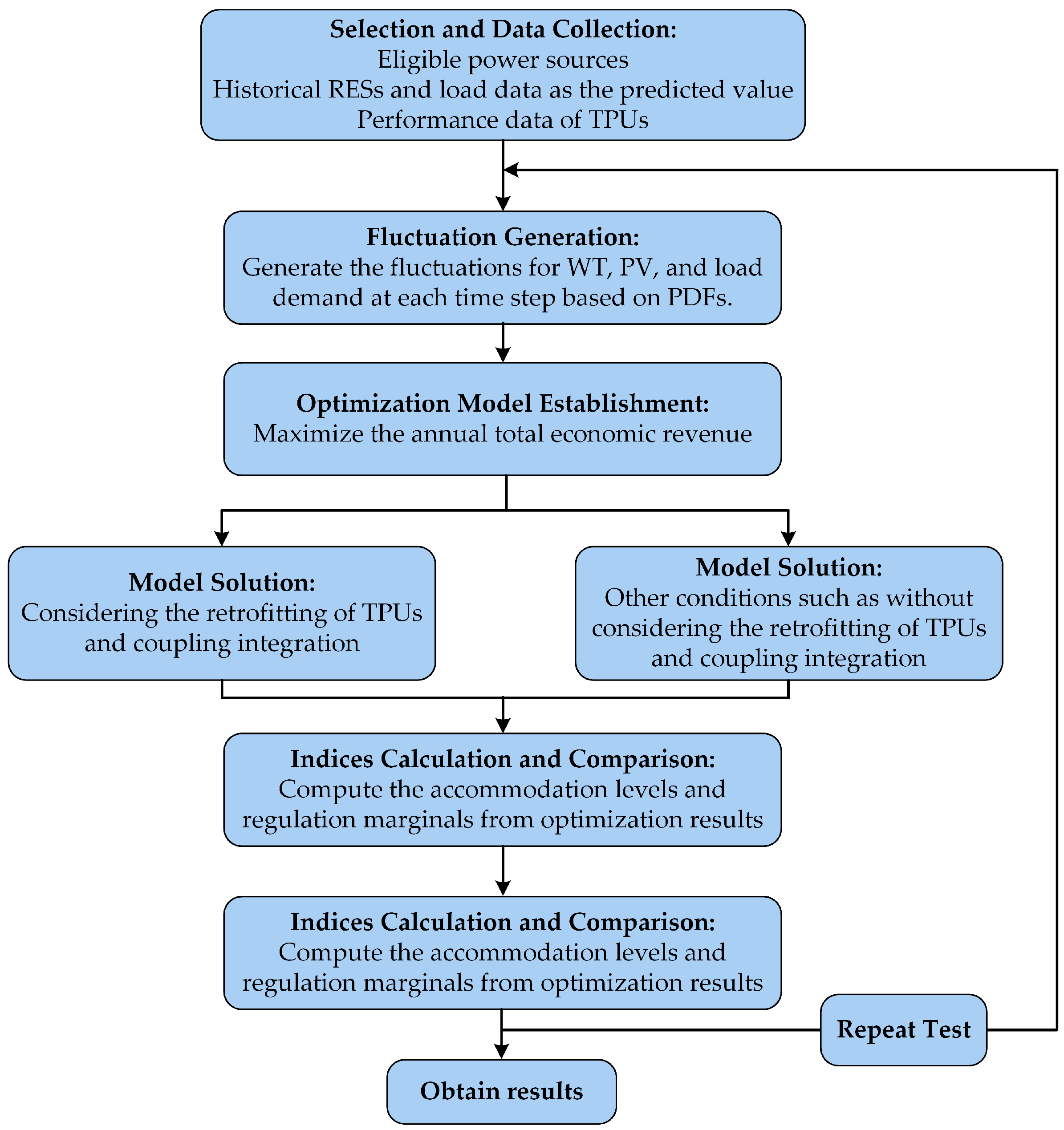

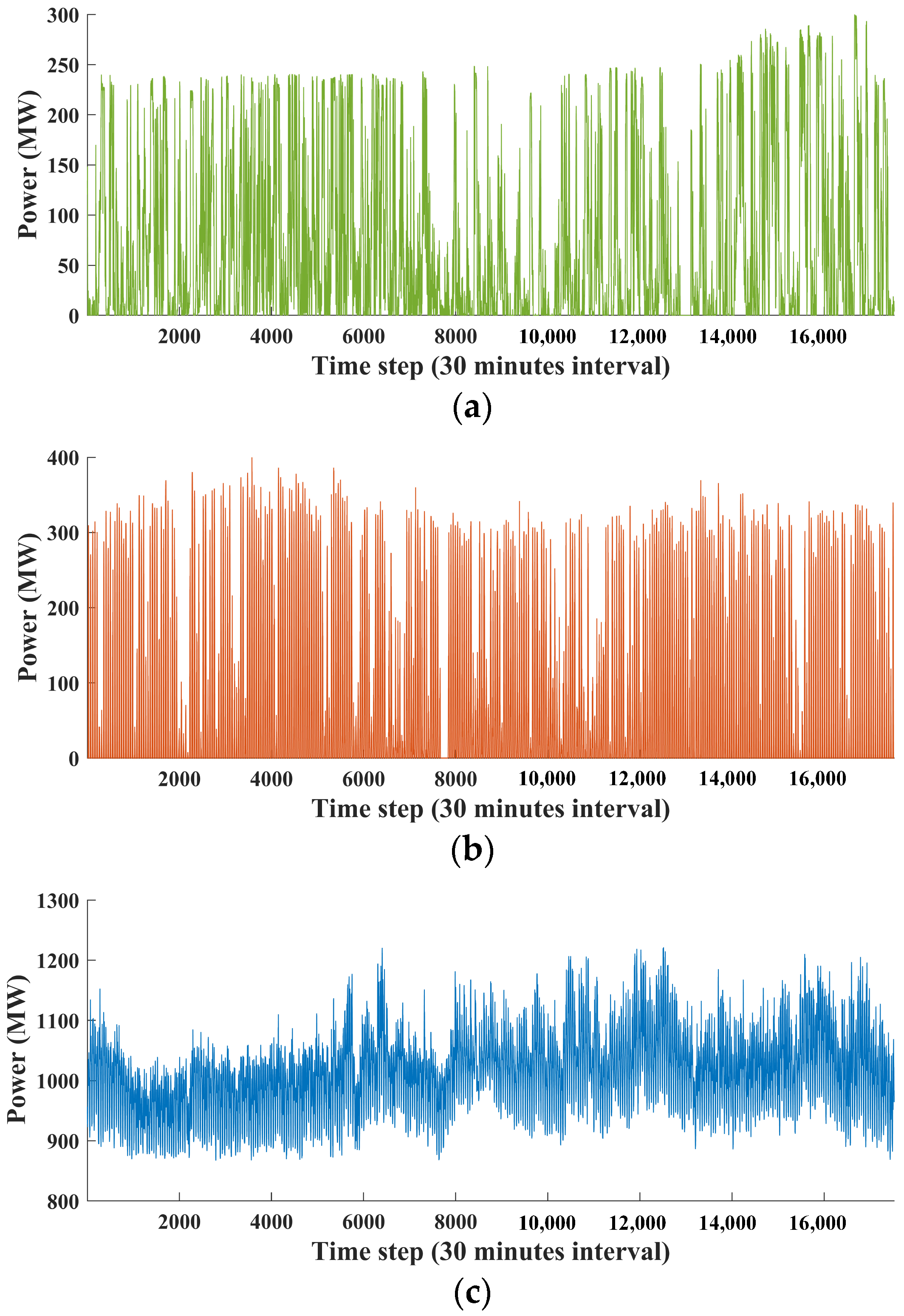
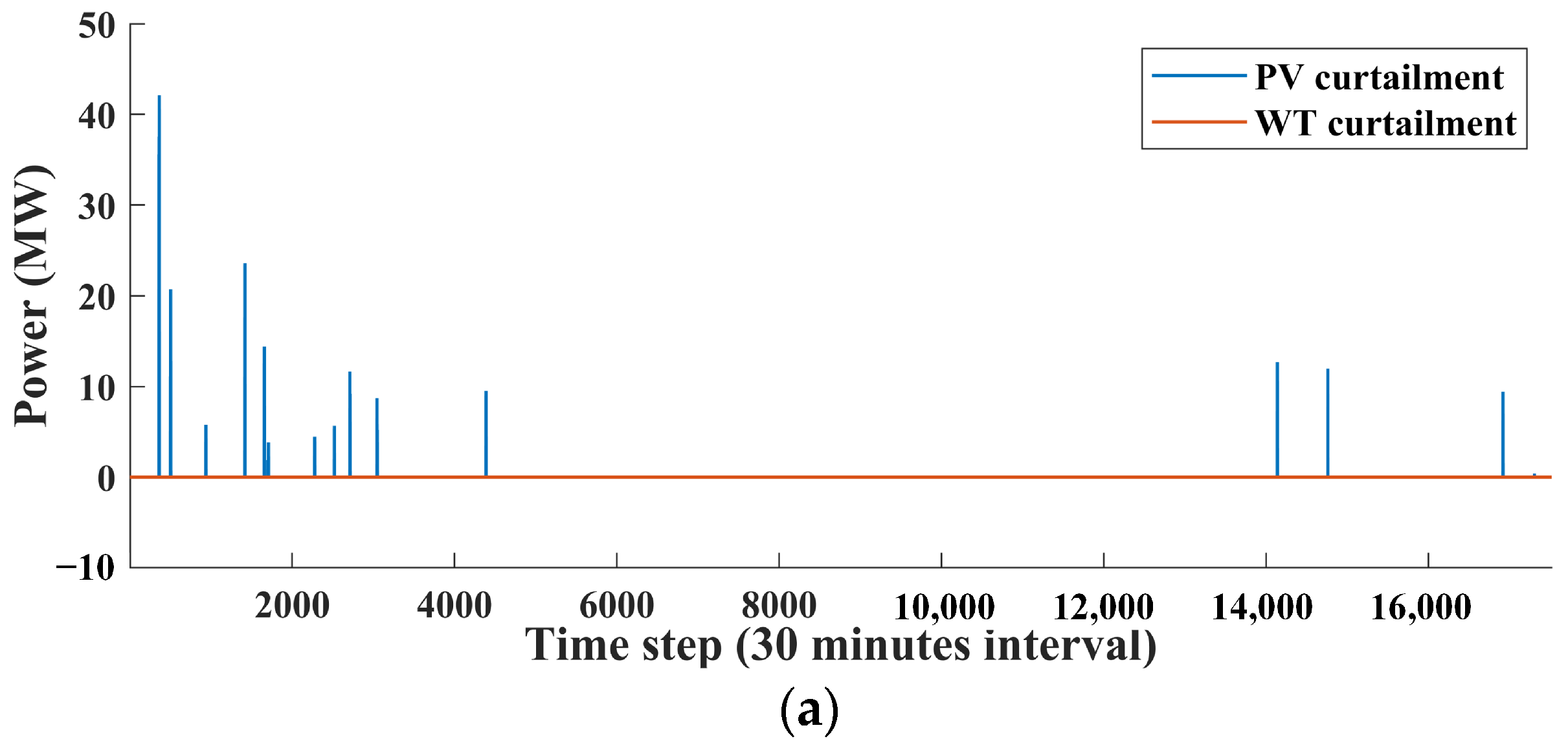
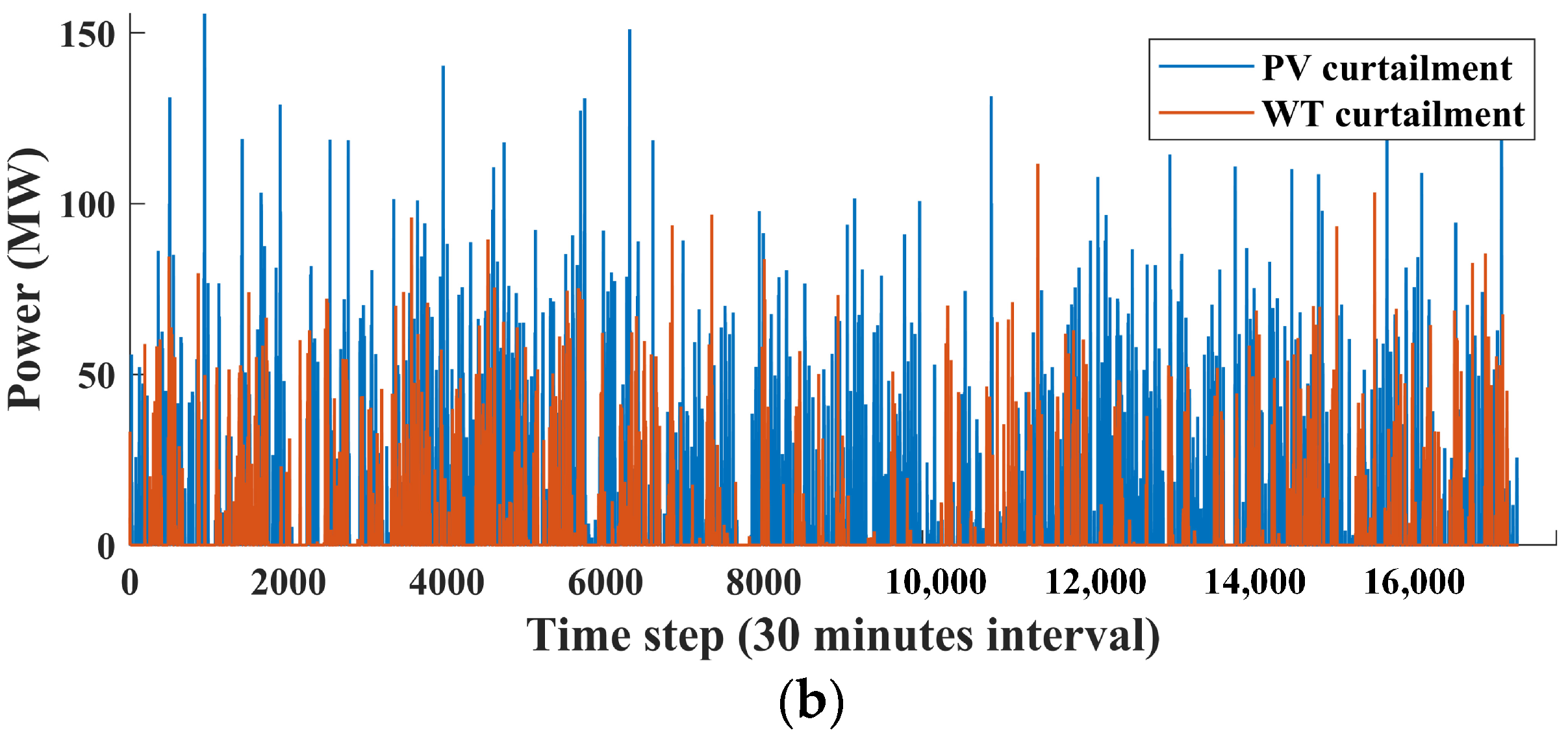
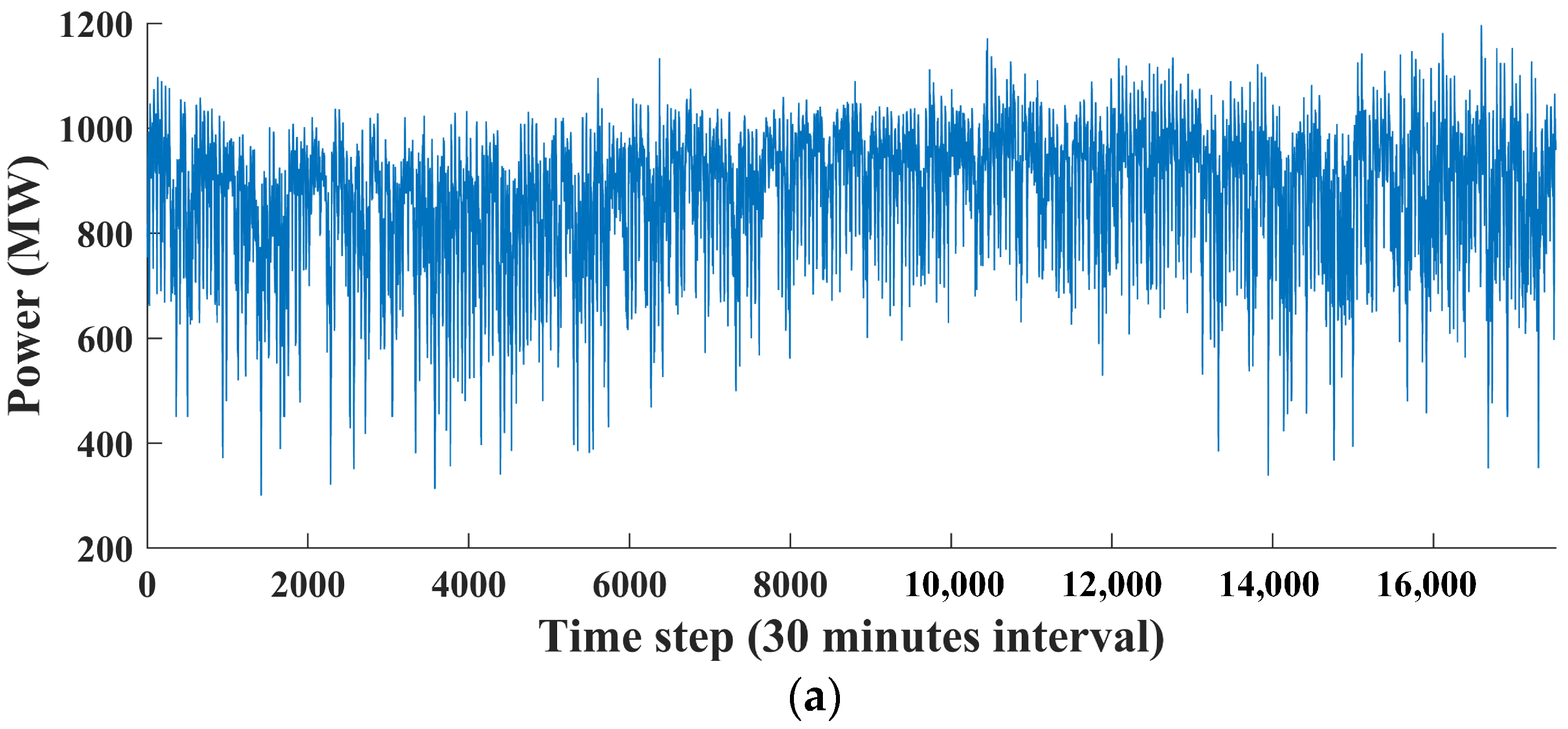

| CGS | BRTGS | VPP | |
|---|---|---|---|
| Objective | Integration of geographically proximate large-scale RES and TPUs on the generation side | Transmission of large-scale RES and TPUs across the power grid | Management and coordination of distributed DERs or generation sources |
| Coordination Method | Utilization of local PCC | Deployment through the high-voltage transmission line | Primarily via the distribution network |
| Function | Mitigation of local RES fluctuations and provision of flexible support | Point-to-point stable power transmission | Integration of regulatory resources for flexible control |
| (MW/min) | (MW/min) | (MW) | (MW) | |
|---|---|---|---|---|
| Before | 9 | 6 | 300 | 180 |
| After | 18 | 12 | 300 | 150 |
| After Coupling Integration with Retrofitted TPUs | Before Coupling Integration and without Retrofitted TPUs | Improvement | |
|---|---|---|---|
| (%) | 100 | 97.41 | 2.59 ↑ 1 |
| (%) | 99.97 | 95.28 | 4.69 ↑ |
| (%) | 99.99 | 96.39 | 3.6 ↑ |
| 154.0386 | 154.8457 | 0.08 ↓ | |
| 280.1582 | 212.1972 | 67.96 ↑ | |
| (MWh) | 6.1327 × 105 | 5.9737 × 105 | 1.59 × 104 ↑ |
| (MWh) | 5.5930 × 105 | 5.3302 × 105 | 5.63 × 104 ↑ |
| Annual revenues (CNY) | 2.1887 × 109 | 2.1736 × 109 | 1.51 × 107 ↑ |
| Coupling Integration with Retrofitted TPUs | Coupling Integration without Retrofitted TPUs [22] | Improvement | |
|---|---|---|---|
| (%) | 100 | 99.91 | 0.09 ↑ 1 |
| (%) | 99.97 | 97.84 | 2.13 ↑ |
| (%) | 99.99 | 98.92 | 1.07 ↑ |
| 154.0386 | 150.8950 | 3.14 ↑ | |
| 280.1582 | 207.8130 | 72.34 ↑ | |
| (MWh) | 6.1327 × 105 | 6.1269 × 105 | 0.058 × 104 ↑ |
| (MWh) | 5.5930 × 105 | 5.4737 × 105 | 1.19 × 104 ↑ |
| Annual revenues (CNY) | 2.1887 × 109 | 2.1883 × 109 | 0.038 × 107 ↑ |
Disclaimer/Publisher’s Note: The statements, opinions and data contained in all publications are solely those of the individual author(s) and contributor(s) and not of MDPI and/or the editor(s). MDPI and/or the editor(s) disclaim responsibility for any injury to people or property resulting from any ideas, methods, instructions or products referred to in the content. |
© 2024 by the authors. Licensee MDPI, Basel, Switzerland. This article is an open access article distributed under the terms and conditions of the Creative Commons Attribution (CC BY) license (https://creativecommons.org/licenses/by/4.0/).
Share and Cite
Zou, Y.; Xia, Q.; Chi, Y.; Wang, Q. Enhancing Renewable Energy Accommodation by Coupling Integration Optimization with Flexible Retrofitted Thermal Power Plant. Appl. Sci. 2024, 14, 2907. https://doi.org/10.3390/app14072907
Zou Y, Xia Q, Chi Y, Wang Q. Enhancing Renewable Energy Accommodation by Coupling Integration Optimization with Flexible Retrofitted Thermal Power Plant. Applied Sciences. 2024; 14(7):2907. https://doi.org/10.3390/app14072907
Chicago/Turabian StyleZou, Yao, Qinqin Xia, Yuan Chi, and Qianggang Wang. 2024. "Enhancing Renewable Energy Accommodation by Coupling Integration Optimization with Flexible Retrofitted Thermal Power Plant" Applied Sciences 14, no. 7: 2907. https://doi.org/10.3390/app14072907




